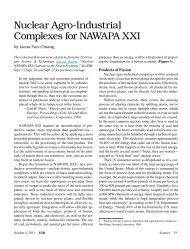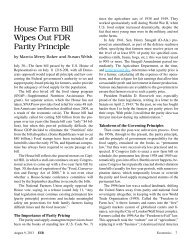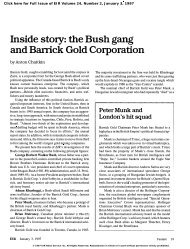View Full Issue - Executive Intelligence Review
View Full Issue - Executive Intelligence Review
View Full Issue - Executive Intelligence Review
You also want an ePaper? Increase the reach of your titles
YUMPU automatically turns print PDFs into web optimized ePapers that Google loves.
•<br />
Brashear wrote, "Perhaps some of the good people will<br />
read these reminiscences who have been fellow workers in<br />
the domain of our beautiful science of astronomy and astrophysics<br />
and who have helped me to 'push forward the frontiers<br />
of human knowledge'. . . . But, after all, my one big<br />
hope is that my humble effort in jotting down these items<br />
from life's memorandum book may help some struggling<br />
soul to master some of the problems oflife and of the beautiful<br />
in science, which will contribute new chapters of discovery<br />
to the now unknown and help to make this old oblate spheroid<br />
move smoother on its axis."<br />
Brashear's autobiography first appeared in 1924, four<br />
years after his death. Readers of this work will be richly<br />
rewarded by a man who makes your vision swell, and your<br />
hopes soar.<br />
Modern aviation's debt<br />
to 'Kelly' Johnson<br />
by Leo Scanlon<br />
1I0re Than lIy Share of It All<br />
by Clarence L. "Kelly" Johnson<br />
with Maggie Smith<br />
Smithsonian Institution Press. Washington. D.C . •<br />
1985. 209 pages. clothbound. $17.50.<br />
Although the name Kelly Johnson may not be familiar to<br />
many people outside the aviation fraternity, his life's work<br />
stands behind the developments in modem aviation which<br />
have captivated the imaginations and spurred the optimism<br />
of several generations of Americans. This autobiography is<br />
a very human look into the life of the man who epitomizes<br />
the genius, and limitations of American industrial technology<br />
in the 20th century .<br />
Kelly Johnson had a hand in almost every engineering<br />
feat of aircraft design in this century, from his work developing<br />
the Lockheed Electra, through a family of transport<br />
and fighter aircraft for World War n, and on, to the fabulous<br />
SR-71 , which is the pioneer for future stealth and hypersonic<br />
aircraft.<br />
A look at these acomplishments shows a man who is<br />
almost a stereotype of the American genius for engineering<br />
and production organization. For example, Johnson was<br />
leading the work on the P-38, the fastest of the subsonic<br />
fighters, when the problem of "compressability" -unstable<br />
air flows at transsonic speeds-was found to plague the air-<br />
EIR August 5, 1988<br />
craft at the edge of its performance envelope. This problem<br />
represented the barrier which made any further attempt to<br />
apply greater engine power, including existing jet engines,<br />
useless, because the airframe could not survive the speeds.<br />
Kelly Johnson reports the admiration he had for the German<br />
engineers (working from classical Riemannian models<br />
of the shockwave effects, whose approach had been rejected<br />
by the Air Force, and Theodor von Karman in the United<br />
States) and their advanced solutions to these problems. Apparently<br />
unaware of the theoretical basis of the German accomplishments,<br />
Johnson was nonetheless able to direct the<br />
engineering and production departments at Lockheed, assimilating<br />
these breakthroughs, and organized the work in what<br />
we now term "Manhattan Project" fashion. The methods he<br />
used are directly responsible for the successes he achieved<br />
from then through the production of the SR-7 1.<br />
This effort, under wartime conditions, impressed on<br />
Johnson the need to run research and engineering projects in<br />
a manner diametrically opposed to the bureaucratic methods<br />
which have come to characterize the moribund corporate and<br />
government structure of the 20th century. In this respect,<br />
Johnson stands with Adm. Hyman Rickover and Gen. Bruce<br />
Medaris as one of the giants of this century. These men, each<br />
in his own way, were characteristically opposed to the shallow,<br />
weak, and timid thinking that characterizes the modem<br />
"consensus process."<br />
Johnson's approach to the problem was to form an organization<br />
within the Lockheed structure, under his direction,<br />
which was nicknamed the "Skunk Works" (after the famous<br />
production site of "Kickapoo joy juice" in the L'iI Abner<br />
comic strip). The Skunk Works operated on principles which<br />
are captured in the humorous slogans of the management, "If<br />
you can't do it with brainpower you can't do it with manpower-overtime."<br />
"Be quick, be quiet, be on time." "Listen:<br />
You'll never learn anything by talking." ''The measure of an<br />
intelligent person is his ability to change his mind." Kelly<br />
Johnson saw this as a "common sense" approach to solving<br />
complicated problems, and it is. He is continually amazed at<br />
the sad lack of this approach in the United States today.<br />
The autobiography describes in shocking detail the devastation<br />
of U. S. scientific and industrial preeminence in the<br />
post-Robert McNamara era, and also the incredible damage<br />
that is being done to every area of basic industrial capacity<br />
by the policies which have dominated the country since<br />
McNamara was at the Pentagon. The list of the issues cited<br />
by Johnson is long, and should be studied by every American<br />
concerned about the ongoing collapse of our defense and<br />
industrial base.<br />
Even more frightening is Johnson's account of his inability<br />
to reproduce his method among a younger generation of<br />
engineers and officers. When the Army began the project to<br />
develop the Cheyenne helicoptor, Johnson and the Skunk<br />
Works crew were asked to set up a satellite shop and expedite<br />
the project. Within a very short time, the project's purchasing<br />
Books 19

















